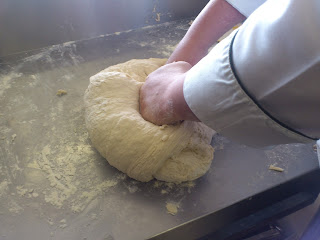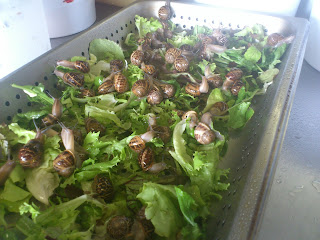This is one of the most beautiful breads in the world, and also on of the most misconceived breads to make, it is not a simple little task of mixing together flour, yeast, salt and water, leaving it to proof and then baking it, it has a lot more to it than that, firstly you have to make a poolish, which is short is a preferment of yeast, salt and flour that needs to sit for 12-18 hours, once you have made the poolish, then the work starts, so here we go, this is my interpretation of an authentic FRENCH BAGUETTE.
Ingredients for polish:
250g Stone Ground White Bread Flour
10g Fresh Yeast
200ml Tepid water
Method
Mix the yeast with the water and leave for 10 to 20 minutes until it is all foamy on the top, then mix this into the flour until combined place in a bowl that is quite high as this is going to rise very high over the next couple of hours, sprinkle a little flour on top of this and cover with a very damp tea towel and leave in a draft free place for 12 to 18 hours, it will have a slight sour beer aroma to it when it is fully prefermented.
Ingredients for Baguette:
750g Stone Ground White Bread Flour
25g Fresh Yeast
400ml Tepid water
1 ½ TBSP good quality salt (I use Oryx Desert Salt as it has no additives at all)
Method
Place the flour and salt on to a work table and make a well in the middle, mix together the yeast and water and leave to sponge as before, then pour the yeasty water into the well.
Now mix the flour in with your fingers going around and touching the sides to bring the flour into the middle. When you have brought in most of the flour and the mixture starts to get pastey, then you can scrape in the rest of the flour.
Now gently work this for about 1 minute and then add in the poolish.
Now you need to knead this for about 10 minutes until smooth and elastic, it is a very “sloopy” dough so don’t be tempted to add more flour, the more you work it the less “sticky” it will become.
Once you are finish kneading the dough you need to place it in a larger bowl that has been oiled so that it doesn’t stick, sprinkle a little flour on the top and cover with a tea towel, and leave in a draft free place for about 1 hour to proof.
Once it has proofed for an hour you now need to fold the dough, you do this be gently removing it from the bowl, lightly stretching it and folding it in 3.
Then place it back into the bowl and leave for another 45 minutes, then you will repeat the process and leave it for 30 minutes.
After leaving it for 30 minutes, you will now cut the dough into 6 equal pieces,
Then leave it to rest for another 10 minutes. Now you can start to shape the dough into the shape of the baguette and place onto a oiled baking tray and, sprinkle with flour cover with a warm damp tea towel for 35 minutes until double in size
Then make a couple of slits on the top of the breads with a very sharp knife, be careful not to “knock out” any air
Place in a pre-heated oven at 200˚c with a bowl of steaming water in it and back like this for 15 minutes, then take out the water drop the heat to 180˚c and bake for a further 15 minutes. It will be ready when you knock it on the bottom and the bread sounds hollow.
And there you go, what may seem as a simple little bread has just transformed into something so magical and special, the smell, texture and mouth feel like you’ve never had before.
Bon Apetit.
Chefs Tips: I make these without using measuring equipment, and it time you need to learn the feel of the dough as some flours absorb water differently to others.
Also always sprinkle just a little flour on top of the dough every time you are going to cover it with a tea towel so that it doesn’t stick to the tea towel.
Preheat your over 20˚ more than any recipe tells you because this is the heat that you are going to lose when you open the door, then drop the temp to the correct temp.


























































